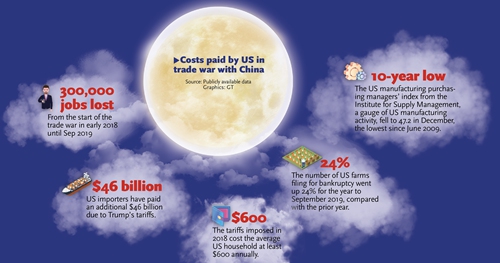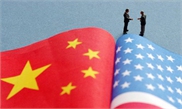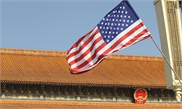
Graphics: GT
China and the US are set to sign the long-awaited phase one trade deal on Wednesday (US time); the deal, which involves a nine-chapter text, has fully taken into account the concerns and interests of both countries, and it is expected to bring the world's two largest economies back on track to stable and sound development, experts close to the deal told the Global Times on Wednesday.
The hard-won text involves nine chapters, touching sectors such as intellectual property rights (IPR), technology transfer, food and agricultural products, financial services, exchange rates and transparency, trade expansion as well as bilateral assessments and dispute settlement mechanisms.
"The phase one deal, which is signed based on an equal footing, is in the interests of both countries and will be a constraining force on both China and the US," Gao Lingyun, an expert at the Chinese Academy of Social Sciences in Beijing who is close to the trade talks, told the Global Times on Wednesday.
As the two reached consensus on the phase-one deal, US agreed to lower tariffs on $120 billion worth of Chinese products to 7.5 percent from 15 percent, but a 25 percent tariff remains on roughly $250 billion worth of Chinese products. The US also rolled back plans to impose tariffs on all additional imports.
"The tariffs will be further scrapped when negotiations in the upcoming months run smoothly," Gao said.

Graphics: GT
New mechanism
Experts said that highlights of the deal include the establishment of an assessment and dispute settlement mechanism to ensure a smooth and effective implementation of the agreement.
If some of the terms fail to be implemented, the two have vowed to settle disagreements through negotiation, in an effort to prevent an escalation of conflicts.
"This will further protect the sound and stable development of China-US relations and pave the road for future negotiations as well," Gao said.
The two are also expected to agree on the expansion of trade connections, including China's large purchases of US goods including agricultural products, energy and services.
China might expand imports of US products such as advanced technology equipment and key components that are needed by Chinese enterprises, sources close to the matter told the Global Times on Wednesday, noting that Chinese companies will be "encouraged" to buy US products and services if they fulfill Chinese people's demand.
Great potential
"China and the US still have great potential to develop their trade. China has the world's largest middle-income group, and this group has huge demand for high-quality products, while the US has the ability to meet that demand, especially in energy, manufactured products, agricultural products, medicine and finance," they said.
The text also includes cooperation in financial services sectors such as banks, securities, insurance and electronic payments.
Experts said it is in line with China's opening up efforts in the finance sector in recent years; and the opening-up measures will apply to all countries without discrimination.
Commenting on the IPR issue, Gao said that strengthened protection in the sector, which China has been pursuing during recent years, will also promote innovation in the country, and the IPR section could also serve as a template for China's trade with other countries and regions.




